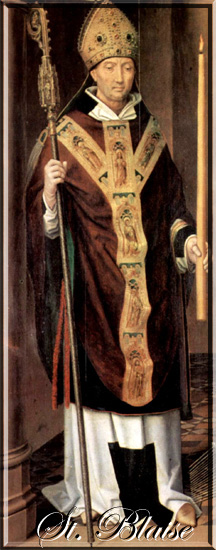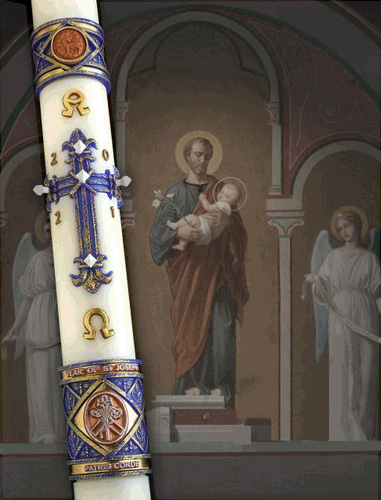 Blessed Candles
Blessed CandlesImprimatur: Michael Augustine,
Archbishop of New York, 1893
Of this blessing, too, we have indications in the Old Testament.
God Himself ordered a golden candlestick with seven
lights to be set up in the tabernacle; and Solomon placed several,
made of the finest gold, in the Temple. How much more,
then, it behooves us to honor by the use of lights the presence of
Our Lord in the Eucharist, at Mass, and in other solemnities of
the Church!
Besides all this, blessed candles when burning have a special significance for ourselves. In the first place, they remind us that we ought to acquire the three divine virtues: faith which illuminates, hope which warms, and charity which inflames; for the candle gives light, warmth, and comfort. Furthermore, they suggest to us Christian love of neighbor; for as the burning taper, while warming us to charity, wastes itself, so too should we enlighten our fellow-men by our good works, and at the same time spend ourselves by our deeds of charity and works of neighborly love for others. As the flame of the candle, no matter how we hold it, always burns upward, so too should all our wishes and efforts be directed from the lower to the higher. Our thoughts should be in heaven. Finally, a burning taper reminds us of the uncertainty and fleetness of human life; for when a candle is lighted it begins to waste, and steadily consumes itself, bearing a lively resemblance to human life: at the moment of our birth we began to die, and our life is gradually wasting away amid the din and struggle of life's battle.
Candles are blessed mostly on the feast of the Purification of the Blessed Virgin, or Candlemas Day, that we may be reminded that Christ is the Light for the enlightenment of the Gentiles, and that we should be children of light.
On that day there is a procession with lighted candles, to place more vividly before our memories the procession of the Blessed Virgin and St. Joseph, together with holy Simeon and devout Anna, to the altar in the Temple, and to honor Mary who gave to us the Light of the world. Blessed candles are used at Baptism and at the death-bed.
Besides all this, blessed candles when burning have a special significance for ourselves. In the first place, they remind us that we ought to acquire the three divine virtues: faith which illuminates, hope which warms, and charity which inflames; for the candle gives light, warmth, and comfort. Furthermore, they suggest to us Christian love of neighbor; for as the burning taper, while warming us to charity, wastes itself, so too should we enlighten our fellow-men by our good works, and at the same time spend ourselves by our deeds of charity and works of neighborly love for others. As the flame of the candle, no matter how we hold it, always burns upward, so too should all our wishes and efforts be directed from the lower to the higher. Our thoughts should be in heaven. Finally, a burning taper reminds us of the uncertainty and fleetness of human life; for when a candle is lighted it begins to waste, and steadily consumes itself, bearing a lively resemblance to human life: at the moment of our birth we began to die, and our life is gradually wasting away amid the din and struggle of life's battle.
Candles are blessed mostly on the feast of the Purification of the Blessed Virgin, or Candlemas Day, that we may be reminded that Christ is the Light for the enlightenment of the Gentiles, and that we should be children of light.
On that day there is a procession with lighted candles, to place more vividly before our memories the procession of the Blessed Virgin and St. Joseph, together with holy Simeon and devout Anna, to the altar in the Temple, and to honor Mary who gave to us the Light of the world. Blessed candles are used at Baptism and at the death-bed.
 The Blessing of the Paschal Candle
The Blessing of the Paschal Candle
The paschal or Easter candle represents the risen Christ, and
also the pillar of fire in the desert. For as in olden time this
fiery pillar led the children of Israel out of Egyptian bondage,
so did Christ, the Risen One, rescue us from the slavery of
Satan.
The paschal candle is blessed on Holy Saturday with solemn and impressive ceremonies. It should be made of bleached wax, in order to symbolize properly the pure and holy body of Christ, which proceeded from the immaculate bosom of the Blessed Virgin. To the candle are attached in five separate openings, in the form of a cross, five grains of incense, which have been blessed that same morning. These five openings represent the five wound-marks of Christ which He retained after His resurrection, and which we shall all look upon on the day of judgment, either to our joy or to our sorrow. The incense grains represent the spices and ointments with which Nicodemus and Joseph of Arimathea embalmed the body of Jesus.
As this Easter candle is an emblem of the risen Saviour, it stands burning on the gospel side of the altar all through Eastertide. After the gospel at High Mass on Ascension Thursday it is extinguished and carried away, in memory of Christ's departure from the earth, when He ascended from Mount Olivet.
* The image on this page is of St. Blaise holding The paschal candle is blessed on Holy Saturday with solemn and impressive ceremonies. It should be made of bleached wax, in order to symbolize properly the pure and holy body of Christ, which proceeded from the immaculate bosom of the Blessed Virgin. To the candle are attached in five separate openings, in the form of a cross, five grains of incense, which have been blessed that same morning. These five openings represent the five wound-marks of Christ which He retained after His resurrection, and which we shall all look upon on the day of judgment, either to our joy or to our sorrow. The incense grains represent the spices and ointments with which Nicodemus and Joseph of Arimathea embalmed the body of Jesus.
As this Easter candle is an emblem of the risen Saviour, it stands burning on the gospel side of the altar all through Eastertide. After the gospel at High Mass on Ascension Thursday it is extinguished and carried away, in memory of Christ's departure from the earth, when He ascended from Mount Olivet.
a lighted candle as was painted by Hans Memling.
http://catholicharboroffaithandmorals.com/